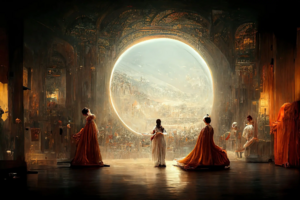Generative artificial intelligence facts for kids
Generative artificial intelligence (also called generative AI or GenAI) is a type of artificial intelligence that can create new things. It can make text, pictures, music, or even videos.
Generative AI uses special computer programs called generative models. These models learn from a lot of existing information, like a huge collection of photos or text. They study the patterns and styles in this information. Then, they use what they learned to make completely new content that looks or sounds similar.
This exciting technology is used in many areas. You can find it in art, writing, making computer programs, designing products, and even in games. Big companies like Microsoft and Google are investing a lot in generative AI. However, people also worry about its misuse. For example, it could be used to create fake news or deepfakes, which are fake videos or audio that look real. These could trick or mislead people.
Contents
How Generative AI Works
Generative AI models are like very smart students. They learn by looking at tons of examples. Imagine you want to teach a computer to draw cats. You would show it millions of cat pictures. The AI would learn what a cat looks like: its fur, eyes, whiskers, and how they are put together. After learning, the AI can then draw a brand new cat that has never existed before!
The AI doesn't just copy. It understands the basic rules and patterns. This allows it to be creative and generate unique content.
What Can Generative AI Do?
Generative AI can create many different types of media. Here are some of the main ones:
Making Text
World knowledge in hand,
Infinite pages unfold,
Wisdom's vast, free land.
Some generative AI systems are trained on huge amounts of text. These are called large language models. They can understand and create human-like language. Examples include GPT-3 and GPT-4.
These systems can:
- Answer questions.
- Write stories or poems.
- Translate languages.
- Summarize long articles.
- Even help you write computer code!
They learn from massive collections of text, like all the articles on Wikipedia or many books.
Creating Images
One of the most popular uses of generative AI is making pictures. These systems are trained on images that have text descriptions. You can type a sentence, like "a robot playing guitar on the moon," and the AI will create a picture based on your words.
Famous image-making AIs include DALL-E, Midjourney, and Stable Diffusion. Many of the pictures they create have even won art awards!
Composing Music
Generative AI can also create music. Systems like MusicLM learn from recorded songs and their descriptions. You can tell the AI, "make a calming violin melody with a rock guitar," and it will generate a new piece of music for you.
Producing Videos
Some advanced AI systems can even make short video clips. They learn from many videos and their descriptions. This allows them to create new videos that make sense and flow smoothly.
Designing Molecules
Generative AI is also used in science! It can help design new molecules, like those used in medicines. By learning about existing molecules, the AI can suggest new ones that might help fight diseases.
Controlling Robots
Generative AI can help robots learn new movements. For example, you could tell a robot arm, "pick up the blue bowl," and the AI would figure out how the robot should move to do that. It helps robots understand what to do based on simple commands.
Generative AI in Action
You might already be using generative AI without knowing it! It powers many tools and apps:
- Chatbots like ChatGPT use generative AI to have conversations with you.
- Coding tools like GitHub Copilot help programmers write code faster.
- Image editors like Adobe Photoshop now have AI features that can create or change parts of pictures.
- Office programs like Microsoft Office can use AI to help you write or summarize documents.
Many generative AI models are also available for free, meaning anyone can use them to create their own projects.
How AI Runs on Devices
The size of a generative AI model affects where it can run:
- Small models can run on your smartphones or even tiny computers like a Raspberry Pi.
- Medium models can run on your laptop or desktop computers. These often need special computer chips called GPUs to work fast enough.
- Very large models need powerful computers in big data centers. These are usually accessed through the internet, like when you use a cloud service.
Rules for Generative AI
Because generative AI is so powerful, there are rules and discussions about how it should be used safely and fairly.
- In the European Union, there are plans for laws that would require AI systems to say if they used copyrighted material to learn. They would also need to label anything created by AI as "AI-generated."
- In the United States, some big AI companies have agreed to put special "watermarks" on content made by their AI. This helps people know if something was created by a computer.
- In China, there are rules for public AI services. These rules say that AI-generated images or videos should have watermarks. They also have rules about the data used to train the AI and say that AI should follow certain values.
These rules are being made to help make sure generative AI is used responsibly and safely for everyone.
See also
 In Spanish: Inteligencia artificial generativa para niños
In Spanish: Inteligencia artificial generativa para niños



